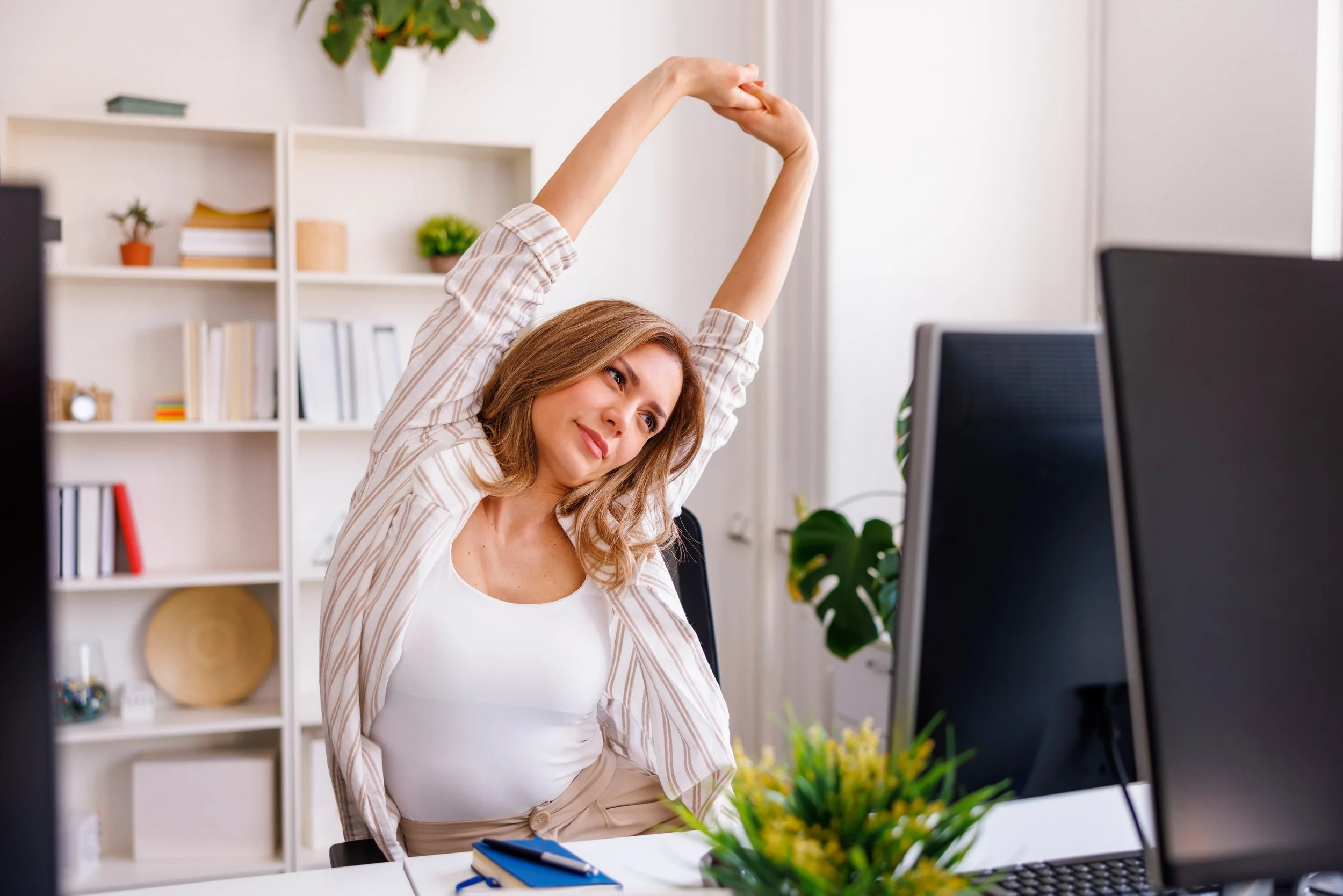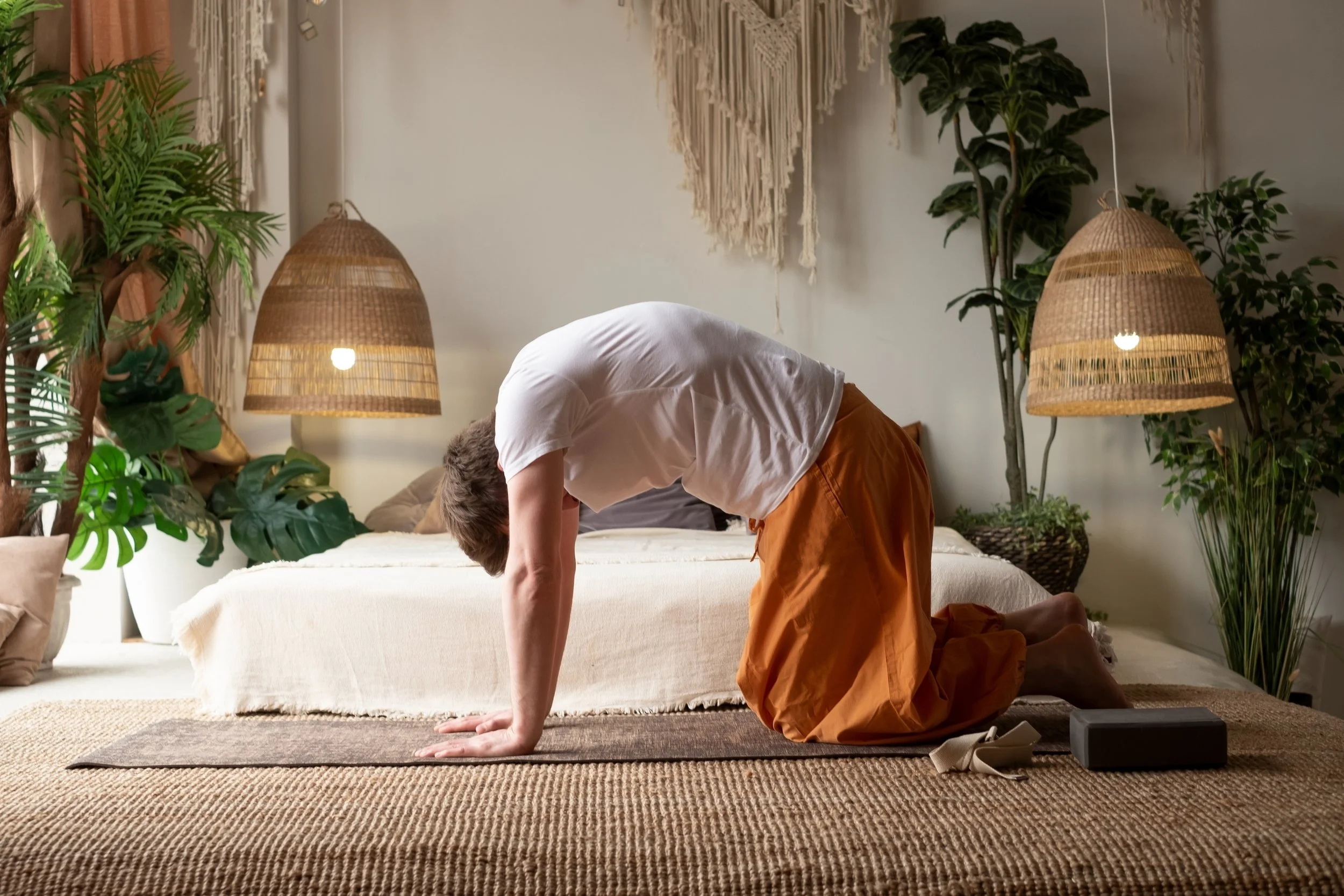Five Essential Stretches to Undo Hours of Sitting
We sit more than any generation before us. At desks, in cars, in meetings, on screens. For many people, sitting is the posture of modern life. But the body is not designed for stillness. Muscles tighten, joints stiffen, circulation slows, posture collapses, and tension builds.
Fortunately, undoing these effects does not require a gym membership or complex routines. A few targeted stretches, practiced consistently, can restore mobility, improve posture, and help your body feel more energized and supported throughout the day.
This article explains why sitting affects the body so deeply and offers simple, expert supported stretches you can do anywhere to reverse its impact.
Why Sitting Is Hard on the Body
Even if sitting feels restful, its effects are not. According to the Mayo Clinic:
“ When you sit, you use less energy than you do when you stand or move. Research suggests that there are health risks from too much sitting. ”
The National Health Service in the United Kingdom notes:
“ Sitting for long periods is thought to slow the metabolism, which affects the body’s ability to regulate blood sugar, blood pressure and break down body fat. ”
The American Cancer Society has found:
“ Sitting time is linked to higher risk of death from all causes. ”
On a musculoskeletal level, Harvard Health Publishing explains:
“ Sitting in a chair all day results in tight hamstrings. A lot of people do not understand that stretching has to happen on a regular basis. ”
In other words, long hours of sitting create physical changes that require intentional movement to reverse.
What Sitting Does to Your Body
Here is what typically happens after hours of being seated:
- Tight hip flexors
- Your hips remain in a closed position, shortening the front of the hip.
- Weak or inactive glutes.
- The large muscles of the hips switch off when you sit.
- Shortened hamstrings.
- This affects how well you can stand tall or move freely.
- Rounded upper back.
- Shoulders slouch forward, creating neck and mid back tension.
- Reduced circulation.
- Blood flow slows, affecting tissue health and energy levels.
- Low grade nervous system stress
- Lack of movement prevents the body from shifting into a truly calm, restorative state.
The stretches below help address each of these issues directly.
Five Essential Stretches to Undo Hours of Sitting
Each stretch is beginner friendly and designed to be done anywhere, including at home, at work, or between appointments.
- Hip Flexor and Quadricep Stretch (Half Kneeling)
What it helps: Tight hips, lower back strain, posture imbalances.
How to do it: Step forward into a lunge. Lower your back knee to the floor. Gently tuck your pelvis under and lean forward until you feel a stretch along the front of your hip. Hold for thirty to forty seconds. Switch sides.
Why it works: This directly lengthens the muscles that become shortest during sitting. When these muscles release, the pelvis and lower back have better alignment.
- Glute Bridge
What it helps: Weak glutes, lower back pressure, pelvic alignment.
How to do it: Lie on your back with your knees bent and feet flat. Press through your heels and lift your hips upward. Squeeze your glutes at the top for one or two seconds, then lower slowly. Perform ten to twelve repetitions.
Why it works: This movement wakes up the glutes, which become dormant while sitting, and helps reduce strain on the lower back.
- Thoracic Spine Rotation
What it helps: Rounded shoulders, stiff upper back, neck tightness.
How to do it: Sit tall or lie on your side. Open your top arm outward until your chest follows the rotation. Take two slow breaths. Return to the starting position. Repeat six to eight times per side.
Why it works: It counters the desk posture that rounds the upper back and collapses chest muscles.
A trainer interviewed by Tom’s Guide emphasized that “prolonged sitting has been called the new smoking,” highlighting how targeted mobility can reverse its damage.
- Seated Hamstring and Calf Stretch
What it helps: Tight hamstrings, restricted stride, lower back discomfort.
How to do it: Sit at the edge of a chair. Extend one leg in front of you with your heel on the floor. Keeping your back straight, hinge forward slightly from your hips. Hold for thirty seconds. Flex your toes toward you for an added calf stretch. Switch sides.
Why it works: Hamstrings shorten any time the hips are bent for long periods. This stretch restores length and improves posture.
Harvard Health reminds individuals to “hold stretches for about thirty seconds and avoid bouncing” to prevent injury.
- Hip and Lower Back Mobilization (Cat Cow or Standing Circles)
What it helps: Stiff lower back, tight hips, lack of movement.
Cat Cow: On hands and knees, alternate between arching your back and rounding it. Move slowly with your breath.
Standing Circles: Stand with feet hip width apart and move your hips slowly in a circular motion in both directions.
Why it works: These movements restore fluidity to joints that become compressed and immobile from sitting.
How to Make This Part of Your Routine
Here are simple ways to integrate these stretches into your day:
Every forty five minutes
Perform one quick stretch.
Morning and evening
Do three or four stretches as a short mobility reset.
During transitions
Before driving, after emails, before meetings — use tiny windows of time.
Leave a mat or cushion nearby
A visible cue makes it easier to stay committed.
Consistency matters more than intensity. These stretches work best when repeated often in small doses.
Safety Guidelines • Move slowly and without force. • Warm the body with light activity before deeper stretching. • Stop immediately if you feel sharp or unusual pain. • If you have injuries or chronic pain, consult a professional before starting.
Conclusion
Hours of sitting reshape the body, often without us noticing until stiffness, fatigue, or discomfort becomes the norm. But with a few intentional stretches, practiced regularly, you can restore mobility, reduce tension, and prevent long term strain.
Movement is the antidote to modern stillness. Try one stretch today. Let that be your commitment to a healthier, more comfortable body.


